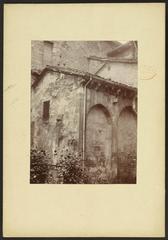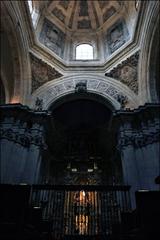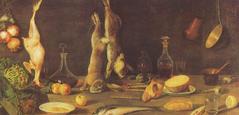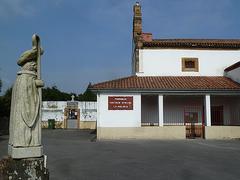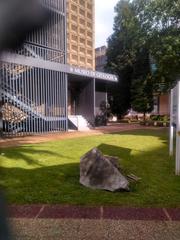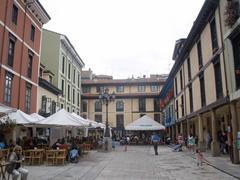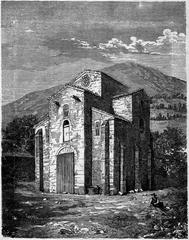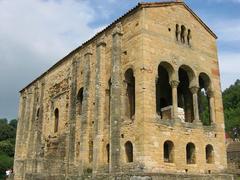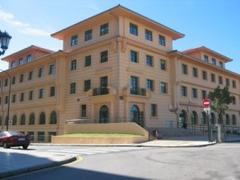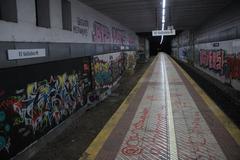San Julián de los Prados: Visiting Hours, Tickets, and Historical Insights in Oviedo City
Date: 23/07/2024
Why Visit San Julián de los Prados
San Julián de los Prados, also known as Santullano, is a pre-Romanesque gem nestled in the heart of Oviedo City, Spain. Constructed in the early 9th century during the reign of King Alfonso II of Asturias, this church stands as a testament to the architectural ingenuity and cultural richness of the early medieval period. The church is renowned for its distinctive architectural style that blends Visigothic, Mozarabic, and Carolingian influences, as well as its extensive and well-preserved frescoes, which rank among the finest examples of early medieval art in Spain. As a UNESCO World Heritage Site, San Julián de los Prados not only attracts tourists from around the globe but also serves as an active place of worship and a focal point for scholarly research. This comprehensive guide aims to provide detailed insights into the church’s historical context, architectural significance, visitor information, and travel tips to ensure a memorable and enriching experience. For more information, visit the UNESCO World Heritage page or the official tourism website.
Table of Contents
- [History of San Julián de los Prados, Oviedo City, Spain](#history-of-san-julián-de-los-prados-oviedo-city-spainhistory-of-san-julian-de-los-prados-oviedo-city-spain)
- [Early Origins and Construction](#early-origins-and-constructionearly-origins-and-construction)
- [Architectural Significance](#architectural-significancearchitectural-significance)
- [Frescoes and Interior Decoration](#frescoes-and-interior-decorationfrescoes-and-interior-decoration)
- [Historical Context and Influence](#historical-context-and-influencehistorical-context-and-influence)
- [Preservation and Restoration](#preservation-and-restorationpreservation-and-restoration)
- [Modern-Day Significance](#modern-day-significancemodern-day-significance)
- [Visitor Information](#visitor-informationvisitor-information)
- [Visiting Hours and Tickets](#visiting-hours-and-ticketsvisiting-hours-and-tickets)
- [Travel Tips](#travel-tipstravel-tips)
- [Special Events and Guided Tours](#special-events-and-guided-toursspecial-events-and-guided-tours)
- [FAQ](#faqfaq)
- [Summary of Key Points](#summary-of-key-pointssummary-of-key-points)
- [References and Further Reading](#references-and-further-readingreferences-and-further-reading)
History of San Julián de los Prados, Oviedo City, Spain
Early Origins and Construction
San Julián de los Prados, also known as Santullano, is one of the most significant pre-Romanesque churches in Spain. Its construction dates back to the early 9th century during the reign of King Alfonso II of Asturias (791-842 AD). This period was marked by the consolidation of the Asturian monarchy and the establishment of Oviedo as the kingdom’s capital. The church was dedicated to Saint Julian and his wife, Saint Basilissa, both early Christian martyrs.
Architectural Significance
San Julián de los Prados is a prime example of Asturian pre-Romanesque architecture, characterized by its unique blend of Visigothic, Mozarabic, and Carolingian influences. The church’s layout follows a basilica plan with a rectangular nave, two aisles, and a triple apse. The central nave is notably higher than the aisles, allowing for clerestory windows that illuminate the interior.
The church’s construction utilized local materials, including limestone and sandstone, which were readily available in the region. The walls are thick and robust, a typical feature of pre-Romanesque architecture, designed to convey a sense of solidity and permanence.
Frescoes and Interior Decoration
One of the most remarkable features of San Julián de los Prados is its extensive and well-preserved frescoes. These frescoes cover the walls and ceilings of the church, depicting a variety of religious and geometric motifs. The frescoes are considered some of the finest examples of early medieval art in Spain.
The iconography of the frescoes includes scenes from the Old and New Testaments, as well as symbolic representations of the heavenly Jerusalem. The use of vibrant colors and intricate patterns reflects the influence of Byzantine art, which was transmitted to the Asturian kingdom through contacts with the Carolingian Empire.
Historical Context and Influence
The construction of San Julián de los Prados occurred during a period of relative stability and prosperity in the Kingdom of Asturias. King Alfonso II, known as “the Chaste,” was a devout Christian who sought to promote the Christian faith and consolidate his kingdom’s cultural identity. The church was part of a broader program of religious and architectural patronage that included the construction of other notable churches, such as Santa María del Naranco and San Miguel de Lillo.
San Julián de los Prados also played a significant role in the development of the Camino de Santiago, the famous pilgrimage route to the shrine of Saint James in Santiago de Compostela. Oviedo was an important stop on the Camino, and the church served as a spiritual and cultural landmark for pilgrims traveling through the region.
Preservation and Restoration
Over the centuries, San Julián de los Prados has undergone several phases of restoration to preserve its architectural and artistic heritage. The most significant restoration efforts took place in the 20th century, led by the Spanish architect Luis Menéndez Pidal. These efforts focused on stabilizing the structure, conserving the frescoes, and restoring the church’s original appearance.
In 1985, San Julián de los Prados was designated a UNESCO World Heritage Site as part of the “Monuments of Oviedo and the Kingdom of the Asturias” listing. This recognition underscores the church’s historical and cultural significance and has helped to ensure its continued preservation.
Modern-Day Significance
Today, San Julián de los Prados remains an active place of worship and a popular tourist destination. The church’s historical and architectural significance attracts visitors from around the world, who come to admire its unique blend of artistic and cultural influences.
The church is also an important site for scholarly research, with ongoing studies focused on its architecture, frescoes, and historical context. These studies continue to shed light on the rich cultural heritage of the Kingdom of Asturias and its contributions to the broader history of medieval Europe.
Visitor Information
Visiting Hours and Tickets
San Julián de los Prados is typically open to visitors from Tuesday to Sunday. Guided tours are available in multiple languages. It is advisable to check the official website or contact the local tourist office for the most up-to-date information on visiting hours and tour schedules.
There is a nominal admission fee for visitors, which helps to support the ongoing preservation and maintenance of the church. Discounts are often available for students, seniors, and groups.
Travel Tips
- Guided Tours: Taking a guided tour is highly recommended, as it provides valuable insights into the church’s history, architecture, and frescoes. Knowledgeable guides can help visitors appreciate the significance of the various artistic and architectural elements.
- Photography: Photography is generally allowed inside the church, but the use of flash is typically prohibited to protect the delicate frescoes. Visitors are encouraged to be respectful and mindful of other worshippers and tourists.
- Accessibility: The church is accessible to visitors with mobility impairments, with ramps and designated pathways available. However, some areas of the church may be more challenging to navigate due to the historic nature of the building.
- Nearby Attractions: San Julián de los Prados is located in the heart of Oviedo, a city rich in history and culture. Visitors can explore other nearby attractions, such as the Oviedo Cathedral, the Archaeological Museum of Asturias, and the historic old town.
Special Events and Guided Tours
San Julián de los Prados occasionally hosts special events, including religious ceremonies and cultural activities. Visitors are encouraged to check the official website or local listings for information on upcoming events.
FAQ
- What are the visiting hours for San Julián de los Prados? The church is typically open from Tuesday to Sunday. Specific hours may vary, so it’s best to check the official website or contact the local tourist office.
- How much are the tickets for San Julián de los Prados? There is a nominal admission fee, with discounts available for students, seniors, and groups.
- Is photography allowed inside San Julián de los Prados? Photography is generally allowed, but the use of flash is prohibited to protect the frescoes.
- Are there guided tours available? Yes, guided tours are available in multiple languages and are highly recommended for a deeper understanding of the church’s significance.
Summary of Key Points
San Julián de los Prados stands as a monumental testament to the architectural and artistic achievements of the early medieval period in Spain. With its unique blend of Visigothic, Mozarabic, and Carolingian influences, the church not only provides a window into the past but also serves as a beacon of cultural heritage for future generations. The preservation efforts led by notable architects and the recognition by UNESCO underscore the global significance of this pre-Romanesque masterpiece. Whether you are a history enthusiast, an art lover, or a casual traveler, a visit to San Julián de los Prados offers a profound and enriching experience. Its well-preserved frescoes, architectural innovations, and historical context provide invaluable insights into the Kingdom of Asturias and its contributions to medieval European history. As you explore this remarkable site and its surrounding attractions in Oviedo, you will undoubtedly come away with a deeper appreciation for the rich cultural tapestry that defines this region. For the latest updates on visiting hours, events, and guided tours, be sure to check the official tourism website and follow related social media channels.
References and Further Reading
- Visiting San Julián de los Prados - History, Tickets, and Tips for Exploring Oviedo’s Pre-Romanesque Gem, 2024, source
- Exploring the Architectural Marvel of San Julián de los Prados - History, Tickets, and Visiting Hours, 2024, source
- San Julián de los Prados - Visitor Tips, Tickets, and Opening Hours in Oviedo, 2024, source

